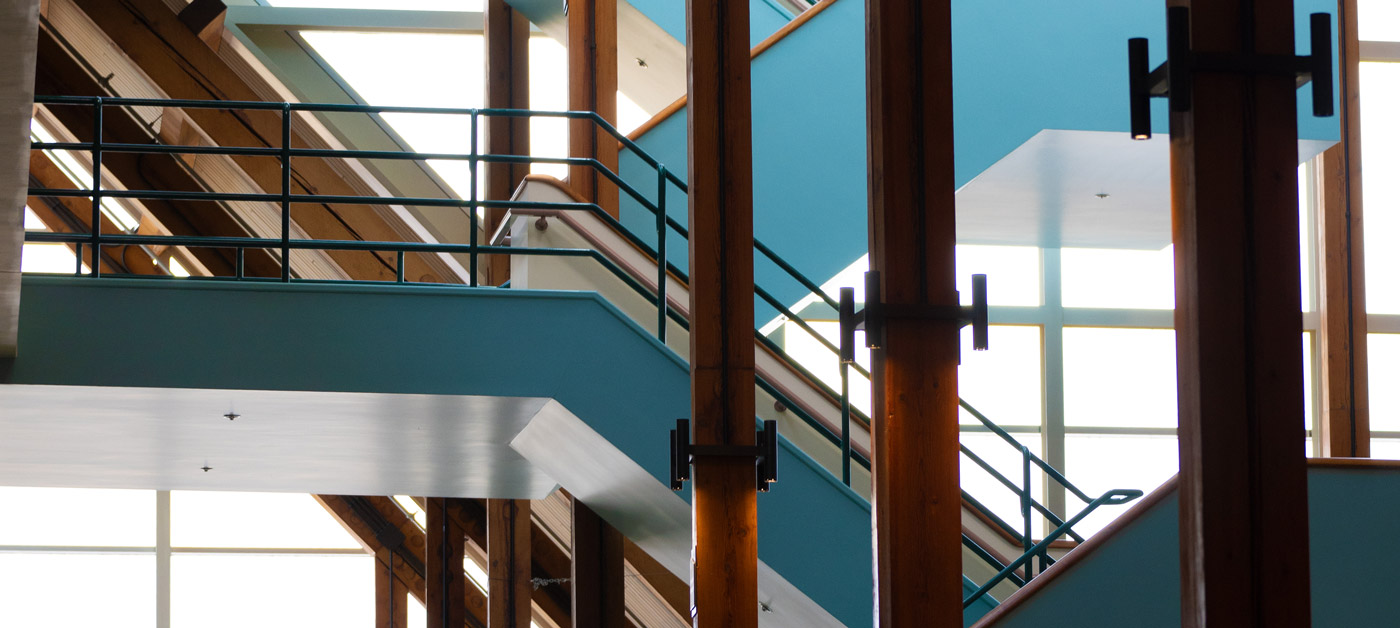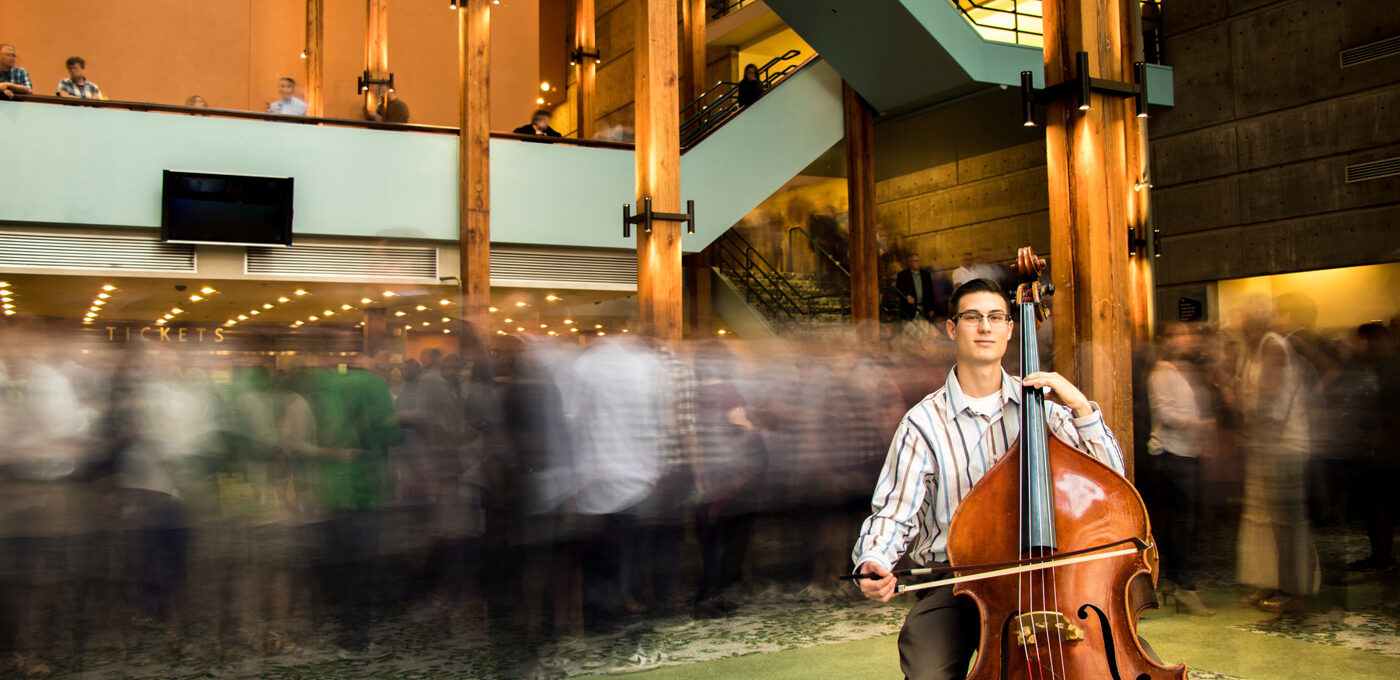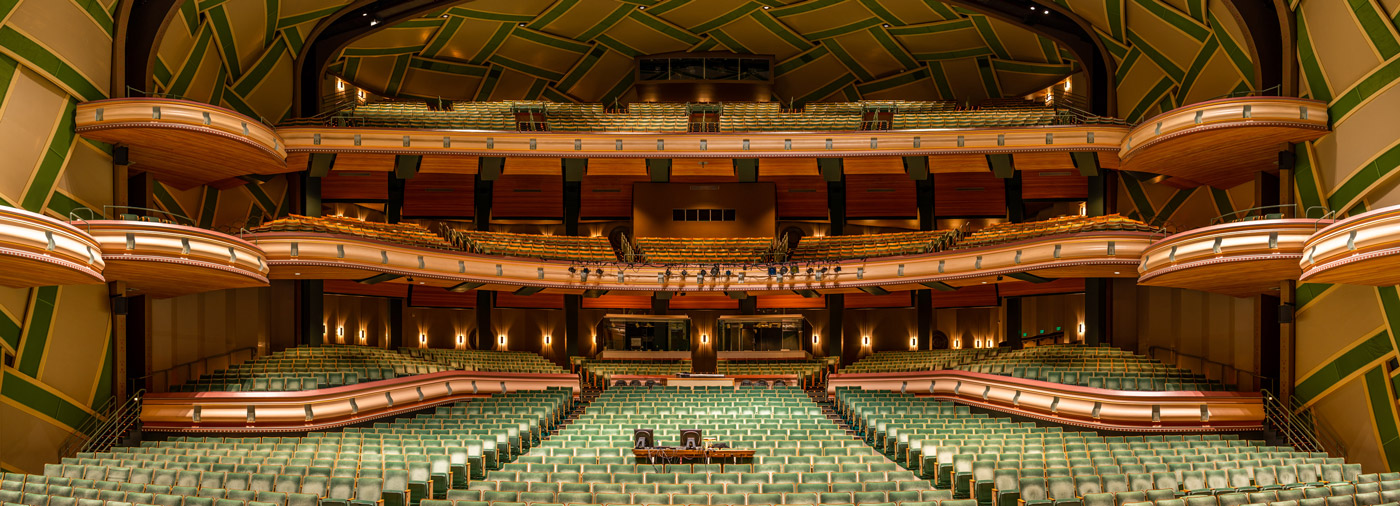When you walk into the Hult Center, the architecture is symbolic, making the entire venue a piece of public artwork of sorts. When viewed from the east, the Hult Center’s roofline mirrors the Cascade Mountains. Douglas fir beams represent the forests. The blue staircase represents our rivers. The flowery pattern of the carpet symbolizes the forest floor. Throughout the building are numerous examples of public art, including Peter Helzer’s bronze statues of two female dancers, and dozens of paintings and sculptures (go on a treasure hunt for six life-size cast bronze sculptures — see the sidebar for more information).

The Hult Center was designed by Hardy Holzman Pfeiffer Associates, a New York–based architectural firm that also happened to design a performing arts venue in Alaska (so if you’re ever in Anchorage for an event, you could have an experience very much like the one here at home). With so much natural beauty to draw on for inspiration, designing the building was not the difficult part. The challenge was convincing the public that Eugene needed a venue. Once approved, construction began in 1979 and the Hult Center opened to the public on September 24, 1982. At that time, Eugene — and much of the world — was in a severe recession
Overcoming Obstacles
Some influential people in Eugene’s past believed that our town could support a venue for local, national, and international performers. Voters rejected the idea two years in a row before approving it. The Hult Center was funded by a city measure and through private donations, making it the first performing arts center in the United States that was built without state or federal funding.
“That was very important because the community came forward to build this,” says Theresa Sizemore, the Hult Center’s general manager. “At that time there wasn’t a guide to follow for programming for a local center like this. You had big centers like the Kennedy Center and the Lincoln Center that everybody knew, but the Hult Center was unusual. It put Eugene on the map for touring companies to stop in here, including Broadway. And it helps a lot of other organizations be able to pull in tours as well.”
Back then, Eugene was a community of 78,000 people, so the idea that our town could support a venue like this was frequently ridiculed. But the vision was there, and the key backers of the project persisted. The center’s construction coincided with the building of the Hilton hotel and conference center next door (now The Graduate), and the enactment of a 1% for public art ordinance in 1981.
The Founders
Thanks to Eugene’s strategic location on I-5, it’s long been a popular stop for touring acts. According to the book The Hult Center — From Dreams To Reality, published in 1987 and written by Marvin and Dana Tims, famous artists frequently came through on the train starting around 1869, just a few years after Eugene was incorporated as a city in 1862. We had a wooden opera house in 1882, which was rebuilt with bricks in 1903 where the Hult Center is now. In 1963, city leaders formed the Lane County Auditorium Committee, LCAA, to persuade voters to fund a performing arts center. That would involve a lot of fundraising, and much of that work was done by Ed Ragozzino, who was South Eugene High School’s drama director. A nine-performance run of “My Fair Lady” netted nearly $30,000.
Ragozzino, who died at the age of 79 in 2010, later led the theater department at Lane Community College, where the name of the Ragozzino Performance Hall honors him. It’s said that Ragozzino’s performances were so good that audience members would suffer through summer shows in the cramped and unventilated high school auditorium, and it was partly this experience that helped convince the community that a better performance venue was warranted.
Other notable backers included Jean and Wayne Tate (of Jean Tate Real Estate), Maurie and Sylvia Jacobs (of M. Jacobs Furniture and the Maurie Jacobs Park), Skeie’s Jewelers, John Jaqua (an attorney and philanthropist who helped found Nike), Herb and Sally Nill (founder of Guaranty Chevrolet and RV centers), Verna and Thomas Wildish (who founded the Wildish family of construction companies in 1935), John and Willa Alvord (whose homestead turned into the Alvord Farm and Museum), the Baker family (who founded the Register-Guard newspaper), philanthropists Donald and Willie Tykeson, philanthropist Donna Woolley, Barbara and Bill Bowerman (who were John Jaqua’s neighbors and co-founded Nike), and Charles and Hope Pressman (who were active in the University of Oregon and arts communities).
The Hult Center is named for Nils and Jewel Hult. Nils was a member of the Civic Center Commission, a group of 15 people who would continue the work of the LCAA. The Hult’s gift of $3 million ensured the center’s construction. The 2,500-seat Silva Concert Hall was named for Julio and Elizabeth Silva to honor a contribution from their daughter, Carolyn Chambers. She founded KEZI-TV in Eugene in 1959 and went on to become president of Chambers Construction. The 495-seat Soreng Theater is named after Eugene philanthropists John and Betty Soreng.

The Early Years
Opening night belonged to mezzo-soprano Marilyn Horne and the Eugene Symphony Orchestra in the Silva Concert Hall, and “The Riverboat Ragtime Revue” in the Soreng Theater. Three days earlier, the center hosted country singer Tommy Overstreet in a Hardhat Concert for all of the workers and builders. In attendance that first night was classical guitarist Mason Williams (composer of “Classical Gas”) who split his time growing up between Oklahoma and Oakridge. He canoed into town from Springfield while wearing a tuxedo and red high-topped sneakers and then carried his canoe to the Hult Center, where the Tims say he asked an attendant to park it. Eugene’s mayor at the time, Gus Keller, cut the ribbon, and the crowd began to explore the Hult Center for the first time. The master of ceremonies was David Ogden Stiers of “M*A*S*H*” fame, who was a former resident of Eugene.
The Hult sold its one-millionth ticket in August 1986, for “Guys and Dolls,” which was part of the Eugene Festival of Musical Theater. At first, the Hult Center presented their own shows. Presenting is challenging because it’s the venue that takes the risk, says Vickie Infinito, the Hult Center’s director of programming and booking. “You’re paying an artist and you have to make sure that your ticket sales cover all of your costs,” she says.
Sizemore says the 2008 recession took a toll on the center’s funding and programs. The center suspended its presenting program in 2010 with the plan to bring it back with a more sustainable model. Until then, the center proceeded as a rental venue for both local and touring performing arts organizations.
“That first presenting mission was much more narrow because it only applied to music and touring acts that fit very specific guidelines,” says Sizemore. “We brought presenting back in 2015 with a much wider mission toward filling gaps and presenting more commercial touring.”

The Hult Today
When Infinito joined in 2015, her primary focus was presenting. Infinito has programming experience at venues in Los Angeles and Seattle, and even though Eugene is much smaller, she still rejoices over the many programming opportunities.
“Anything that is happening in Portland, Seattle, or San Francisco can also happen here,” she says. “We have a voracious arts-going population here. It was important to me to think about things that I would have programmed elsewhere that could also make sense here. Our goal was and is to make the Hult Center enter a place where everybody feels welcome and everybody can find something that they enjoy, whether it is comedy, a rock show, Broadway, or our resident companies.”
Now, about 200,000 people buy Hult Center tickets each year. The center hosts more than 200 ticketed events each year, and between 700 and 800 non-ticketed events like rehearsals, receptions, and pre-talks. And it’s just getting busier, they both say.
When Sizemore joined 18 years ago, the Hult was presenting 10 or 12 touring shows a year. Now, they’ve presented 20 shows just in the month of March. The Hult was able to survive the pandemic closure and open again in September 2021 thanks to city support, an operating reserve, and a federal Shuttered Venue Operators Grant.
“We sucked it in while we were closed and kept people working and accomplished just about every backlogged project that we had, which was pretty amazing,” says Sizemore. “And since we didn’t know what our future was, we could look at strategic planning in a different way.”
When they reopened, 98% of the center’s event staff came back and regular staff was still in place. Although the art world in general is still recovering from the pandemic, the Hult Center was better prepared than most venues to welcome back touring and local performances.
When it comes to projecting an awe-inspiring show, having the right equipment is key. Over the years, renowned artists have performed on stages across the world, leaving their mark by signing the walls behind them. Acts like Sarah Vaughn, Tom Waits, Elvis Costello, Johnny Cash, and Ella Fitzgerald are just a few examples. However, modern-day performers like Manual Cinema from Chicago are taking projection to the next level with overhead projectors and live music.
The Hult also frequently works with Eugene’s Harmonic Laboratory, which creates interactive art installations. It’s that variety of local and touring performance experiences at different price points that keeps things exciting at the venue, in a setting where everyone should feel welcome attending. When combined with the Hult Center’s resident companies — Eugene Ballet, Ballet Fantastique, Eugene Concert Choir, and Eugene Symphony — Eugene arts lovers have a lot to be excited about.

The 40th Anniversary Celebration
The Hult Center’s official birthday is September 24, which they will celebrate with the Broadway hit “Hamilton’’ appearing September 13-25. The center will celebrate August 26-27, with an evening performance by Pink Martini on the 26th and a community open house on the 27th. The team has also embarked on a strategic facility planning process to plan for the future.
“The idea is to really honor the past and the vision that built us, and take our vision forward and see the Hult Center to its full potential and beyond,” says Sizemore. “This season we’re launching a full-on program of community education and engagement, which the Hult Center has never really had.”
But when you’re inside the Hult Center, don’t mention her big birthday. Sizemore’s voice lowers to a whisper as she says, “The building is called the Diva, and when you remind her how old she is, she breaks things.”
So say your congratulations outside, then toast to many more years of the Hult Center once you get your ticket scanned.
The Hult Center, One Eugene Center (7th & Willamette), Eugene, 541/682-5000, hultcenter.org


